ASRock Brings Zen 2 NUC : 4X4 BOX-4800U Renoir Mini-PC Reviewed
by Ganesh T S on November 25, 2020 11:00 AM ESTMiscellaneous Performance Metrics
This section looks at some of the other commonly used benchmarks representative of the performance of specific real-world applications.
3D Rendering - CINEBENCH
We use CINEBENCH R23 for 3D rendering evaluation, but continue to present R15 results till we build up a database of R23 results. The R15 program provides three benchmark modes - OpenGL, single threaded and multi-threaded. Evaluation of different PC configurations in all three modes provided us the following results.
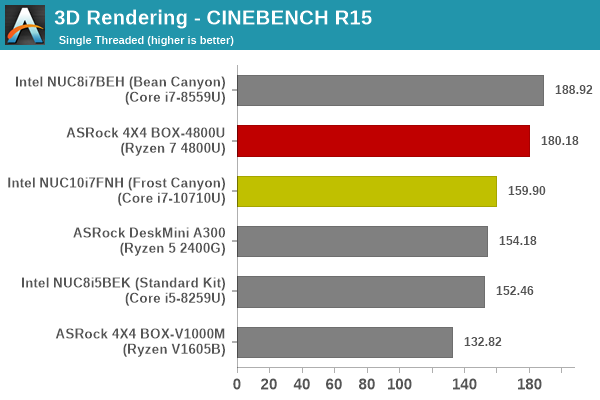


The 4X4 BOX-4800U is ahead of the Frost Canyon NUC across the board, though the single-threaded performance is quite close for this particular rendering workload.


x265 Benchmark
Next up, we have some video encoding benchmarks using x265 v2.8. The appropriate encoder executable is chosen based on the supported CPU features. In the first case, we encode 600 1080p YUV 4:2:0 frames into a 1080p30 HEVC Main-profile compatible video stream at 1 Mbps and record the average number of frames encoded per second.
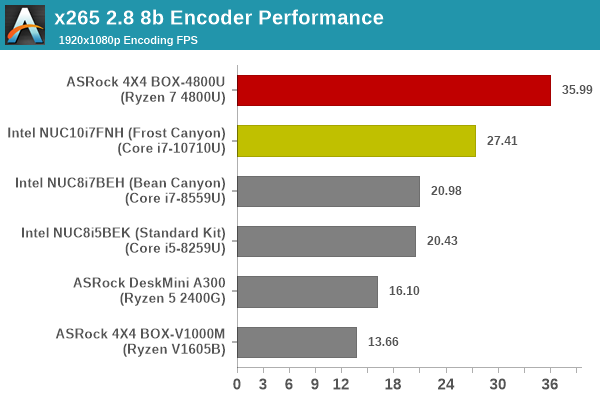
Our second test case is 1200 4K YUV 4:2:0 frames getting encoded into a 4Kp60 HEVC Main10-profile video stream at 35 Mbps. The encoding FPS is recorded.

The workload is a perfect fit for parallelizing and executing across multiple cores, and the 4x4 BOX-4800U emerges as the comfortable leader, thanks to its octa-core nature.
7-Zip
7-Zip is a very effective and efficient compression program, often beating out OpenCL accelerated commercial programs in benchmarks even while using just the CPU power. 7-Zip has a benchmarking program that provides tons of details regarding the underlying CPU's efficiency. In this subsection, we are interested in the compression and decompression rates when utilizing all the available threads for the LZMA algorithm.
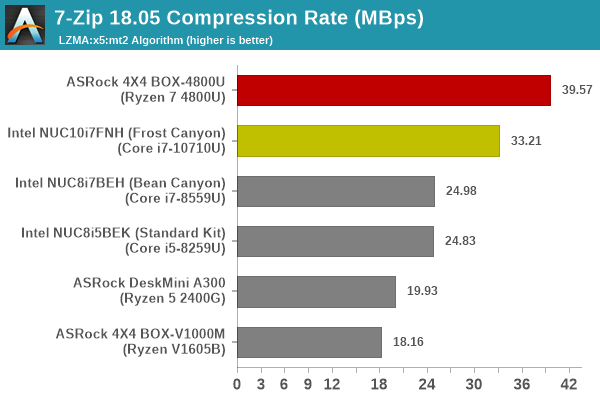

Compression and decompression can also be easily optimized for multi-core processors, and that is evident in the benchmark results above.
Cryptography Benchmarks
Cryptography has become an indispensable part of our interaction with computing systems. Almost all modern systems have some sort of hardware-acceleration for making cryptographic operations faster and more power efficient. In this sub-section, we look at two different real-world applications that may make use of this acceleration.
BitLocker is a Windows features that encrypts entire disk volumes. While drives that offer encryption capabilities are dealt with using that feature, most legacy systems and external drives have to use the host system implementation. Windows has no direct benchmark for BitLocker. However, we cooked up a BitLocker operation sequence to determine the adeptness of the system at handling BitLocker operations. We start off with a 2.5GB RAM drive in which a 2GB VHD (virtual hard disk) is created. This VHD is then mounted, and BitLocker is enabled on the volume. Once the BitLocker encryption process gets done, BitLocker is disabled. This triggers a decryption process. The times taken to complete the encryption and decryption are recorded. This process is repeated 25 times, and the average of the last 20 iterations is graphed below.
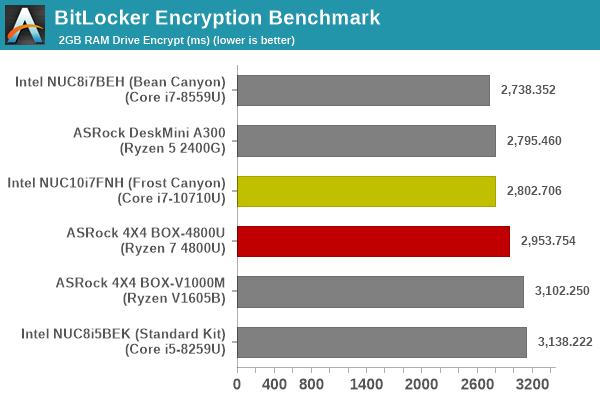
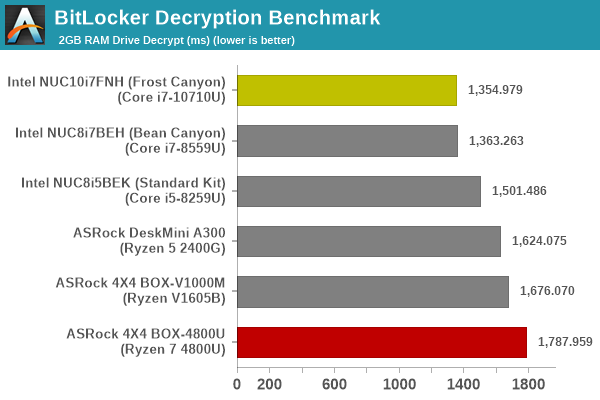
We see the Frost Canyon NUC providing faster encryption support compared to the 4X4 BOX-4800U.
Creation of secure archives is best done through the use of AES-256 as the encryption method while password protecting ZIP files. We re-use the benchmark mode of 7-Zip to determine the AES256-CBC encryption and decryption rates using pure software as well as AES-NI. Note that the 7-Zip benchmark uses a 48KB buffer for this purpose.

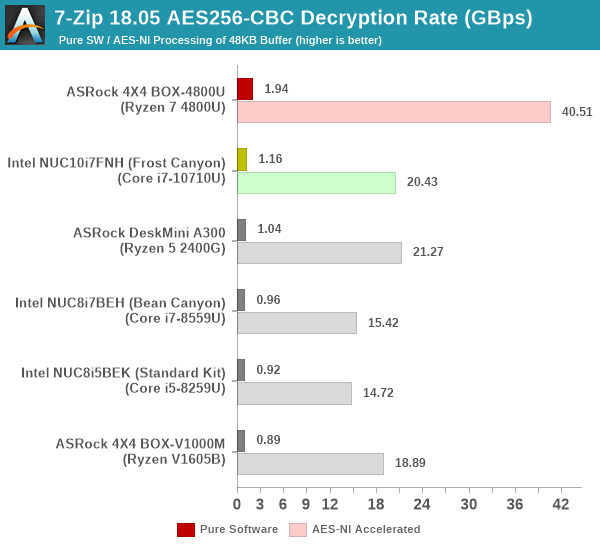
When it comes to password-protected archives, the 4X4 BOX-4800U comes out on top easily.
Yet another cryptography application is secure network communication. OpenSSL can take advantage of the acceleration provided by the host system to make operations faster. It also has a benchmark mode that can use varying buffer sizes. We recorded the processing rate for a 8KB buffer using the hardware-accelerated AES256-CBC-HAC-SHA1 feature.
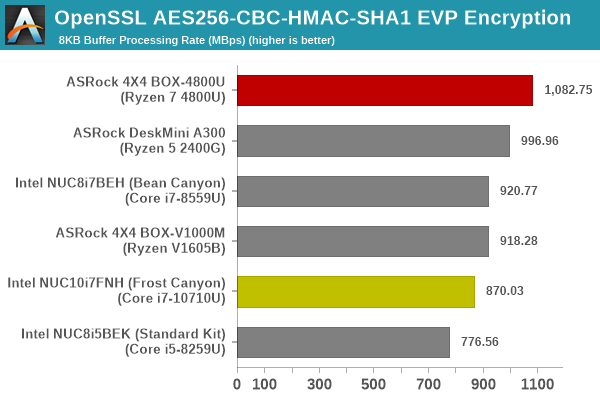

Cryptography engines across all eight cores enable the 4X4 BOX-4800U to score much better than the hexa-core Frost Canyon NUC.
Agisoft Photoscan
Agisoft PhotoScan is a commercial program that converts 2D images into 3D point maps, meshes and textures. The program designers sent us a command line version in order to evaluate the efficiency of various systems that go under our review scanner. The command line version has two benchmark modes, one using the CPU and the other using both the CPU and GPU (via OpenCL). We present the results from our evaluation using the CPU mode only. The benchmark (v1.3) takes 84 photographs and does four stages of computation:
- Stage 1: Align Photographs (capable of OpenCL acceleration)
- Stage 2: Build Point Cloud (capable of OpenCL acceleration)
- Stage 3: Build Mesh
- Stage 4: Build Textures
We record the time taken for each stage. Since various elements of the software are single threaded, and others multithreaded, it is interesting to record the effects of CPU generations, speeds, number of cores, and DRAM parameters using this software.
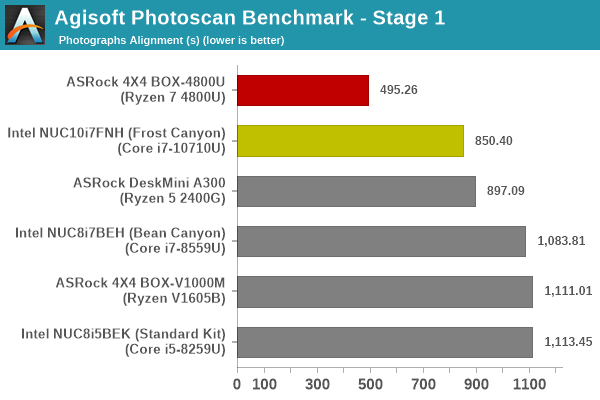
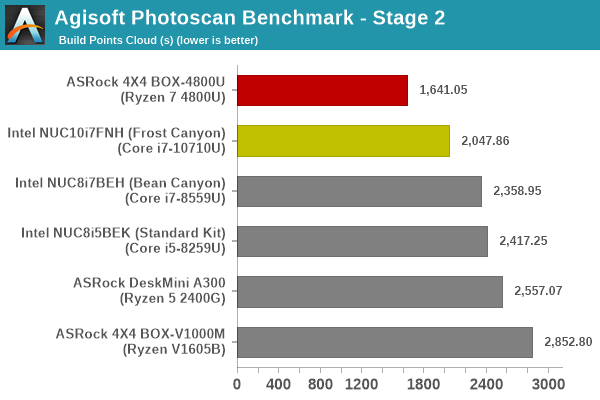
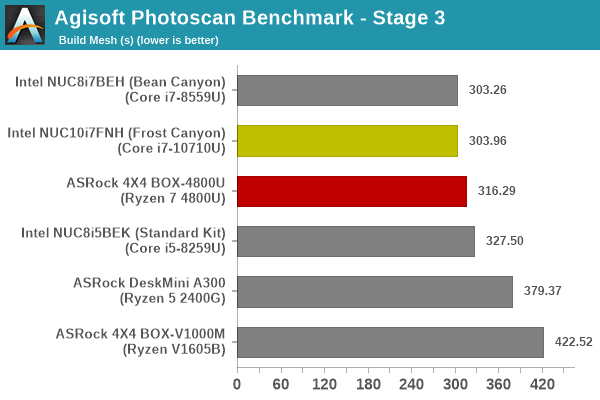
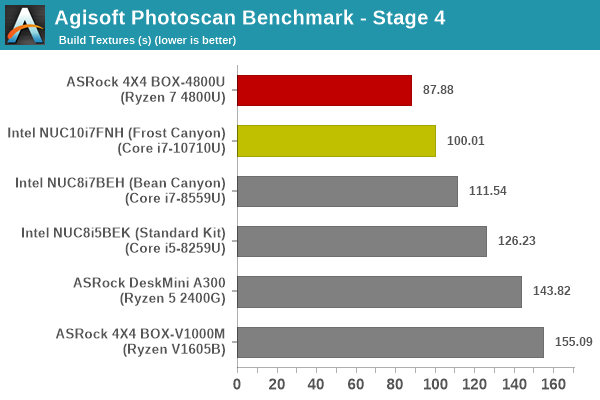
The 4X4 BOX-4800U scores better in three of the four stages, with the third stage seeing the Frost Canyon NUC edge ahead by less than 15 seconds. Overall, the advantage lies with the Renoir system.
Dolphin Emulator
Wrapping up our application benchmark numbers is the new Dolphin Emulator (v5) benchmark mode results. This is again a test of the CPU capabilities.

The emulator is bottlenecked by single-threaded performance, and the Frost Canyon NUC is able to outwit the 4X4 BOX-4800U for this workload.










53 Comments
View All Comments
philehidiot - Wednesday, November 25, 2020 - link
I've been drinking, it's 1900 and I've only eaten breakfast today so bear with me.I'm just astonished that we're now using 64GB DDR4 to eliminate any chance bottlenecking. My last system had 24GB DDR3 and I'm now on 16GB DDR4 with no memory concerns.
As for *hic* SFF HTPC use, AMD has driver issues. I once said to a guy who deals in GPGPU stuff that "I don't have enough experience in drivers or coding to be able to say whether AMD's drivers are good or bad" and his response was "that's the same problem AMD have". If I'm using a PC for relaxing, having to debug or troubleshoot is not ideal. It's a shame, as noted in the conclusion here, that QA is often done on Intel systems and AMD don't get a look-in. Hopefully, as AMD become profitable and more performant they'll be able to convince people to QA on their hardware as well.
They definitely need to sort out their drivers and assess the OEM support for other hardware. It's a sad fact that, since I dropped Intel for AMD (both CPU and GPU), I've had more crashes in a month than in years of Intel/Nvidia systems. I've lost more time to lost work than when I was using Windows 98 and CTRL+S after every change is back to being automatic.
A few months ago I was trying to get 4K working on Netflix and their website specified only Nvidia card support or Intel iGPU decode support. Their support staff had never heard of the issue and so I went through the codecs supported by AMD and pointed out at least their hardware spec page should mention AMD once??? The guy couldn't help so he took it as a comment to escalate higher.
/ramble. I need crisps.
StevoLincolnite - Wednesday, November 25, 2020 - link
Got a secondary AMD rig that is 10+ years old and stays online for weeks at a time without a crash.Still runs games just fine, the more modern titles that are heavier threaded tend to run much better on the old Phenom 2 x6 and paired up with the Radeon RX 580 is a pretty capable 1080P rig.
Will upgrade it when it's useless.
YB1064 - Wednesday, November 25, 2020 - link
$900 is a bit too rich for my blood.BTW, what happened to the latest RTX 3xxx review? Did you guys give up on it?
Makaveli - Thursday, November 26, 2020 - link
Apparently you didn't get the memo.fcth - Friday, November 27, 2020 - link
No explanation as to the delay (originally it was related to the fires in California, but it sounded like they were past that), but Ryan said a couple days ago that they are still getting caught up: https://twitter.com/RyanSmithAT/status/13317467171...damianrobertjones - Wednesday, November 25, 2020 - link
...and Intel's driver support for Intel Nucs is hardly anything to scream about.dontlistentome - Wednesday, November 25, 2020 - link
Took Intel an age (over a year) to fix the BIOS updater on systems with Bitlocker - would fail to suspend the encryption so you'd be left with a machine that wouldn't boot, with a locked drive. Hope you kept the recovery key somewhere accessible.Samus - Thursday, November 26, 2020 - link
OMG I remember that bug, the worst part was there was no way to clone a drive to upgrade the SSD because you couldn't suspend bitlocker so you had to decrypt the drive which takes hours in some cases. 3-4 hour project just to upgrade an SSD...Yorgos - Thursday, November 26, 2020 - link
It took intel 3 or 4 years to fix the N2230 driver on linux.bananaforscale - Thursday, November 26, 2020 - link
I remember when Atoms first came and the NM10 chipset. It had crap support on Linux (didn't support resolutions beyond 800x600 for a while). Then there's Asus Transformer Book that has Intel hardware that's only supported under 32 bit Windows, so no upgrading to 64 bit (even if it would've been a bit silly in that particular case as it only had 2GB RAM). Linux is right out.